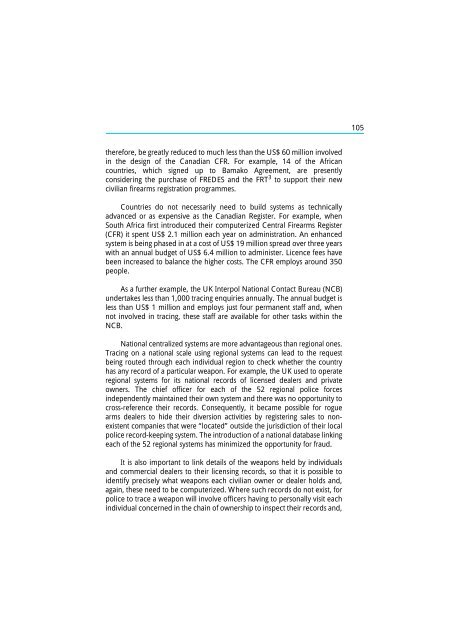The Scope and Implications of a Tracing Mechanism for Small Arms ...
The Scope and Implications of a Tracing Mechanism for Small Arms ...
The Scope and Implications of a Tracing Mechanism for Small Arms ...
You also want an ePaper? Increase the reach of your titles
YUMPU automatically turns print PDFs into web optimized ePapers that Google loves.
105<br />
there<strong>for</strong>e, be greatly reduced to much less than the US$ 60 million involved<br />
in the design <strong>of</strong> the Canadian CFR. For example, 14 <strong>of</strong> the African<br />
countries, which signed up to Bamako Agreement, are presently<br />
considering the purchase <strong>of</strong> FREDES <strong>and</strong> the FRT 3 to support their new<br />
civilian firearms registration programmes.<br />
Countries do not necessarily need to build systems as technically<br />
advanced or as expensive as the Canadian Register. For example, when<br />
South Africa first introduced their computerized Central Firearms Register<br />
(CFR) it spent US$ 2.1 million each year on administration. An enhanced<br />
system is being phased in at a cost <strong>of</strong> US$ 19 million spread over three years<br />
with an annual budget <strong>of</strong> US$ 6.4 million to administer. Licence fees have<br />
been increased to balance the higher costs. <strong>The</strong> CFR employs around 350<br />
people.<br />
As a further example, the UK Interpol National Contact Bureau (NCB)<br />
undertakes less than 1,000 tracing enquiries annually. <strong>The</strong> annual budget is<br />
less than US$ 1 million <strong>and</strong> employs just four permanent staff <strong>and</strong>, when<br />
not involved in tracing, these staff are available <strong>for</strong> other tasks within the<br />
NCB.<br />
National centralized systems are more advantageous than regional ones.<br />
<strong>Tracing</strong> on a national scale using regional systems can lead to the request<br />
being routed through each individual region to check whether the country<br />
has any record <strong>of</strong> a particular weapon. For example, the UK used to operate<br />
regional systems <strong>for</strong> its national records <strong>of</strong> licensed dealers <strong>and</strong> private<br />
owners. <strong>The</strong> chief <strong>of</strong>ficer <strong>for</strong> each <strong>of</strong> the 52 regional police <strong>for</strong>ces<br />
independently maintained their own system <strong>and</strong> there was no opportunity to<br />
cross-reference their records. Consequently, it became possible <strong>for</strong> rogue<br />
arms dealers to hide their diversion activities by registering sales to nonexistent<br />
companies that were “located” outside the jurisdiction <strong>of</strong> their local<br />
police record-keeping system. <strong>The</strong> introduction <strong>of</strong> a national database linking<br />
each <strong>of</strong> the 52 regional systems has minimized the opportunity <strong>for</strong> fraud.<br />
It is also important to link details <strong>of</strong> the weapons held by individuals<br />
<strong>and</strong> commercial dealers to their licensing records, so that it is possible to<br />
identify precisely what weapons each civilian owner or dealer holds <strong>and</strong>,<br />
again, these need to be computerized. Where such records do not exist, <strong>for</strong><br />
police to trace a weapon will involve <strong>of</strong>ficers having to personally visit each<br />
individual concerned in the chain <strong>of</strong> ownership to inspect their records <strong>and</strong>,
















